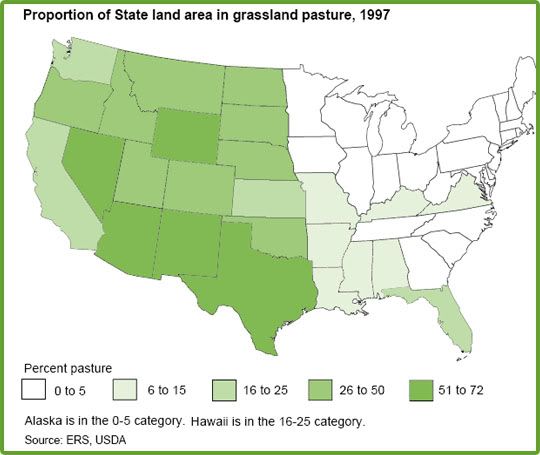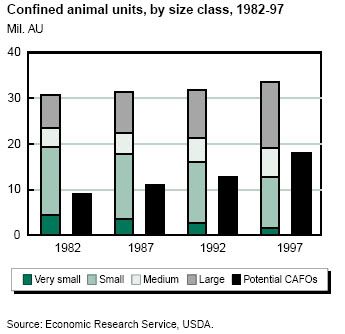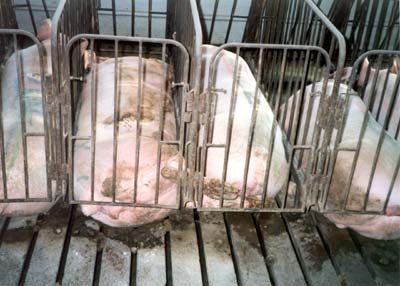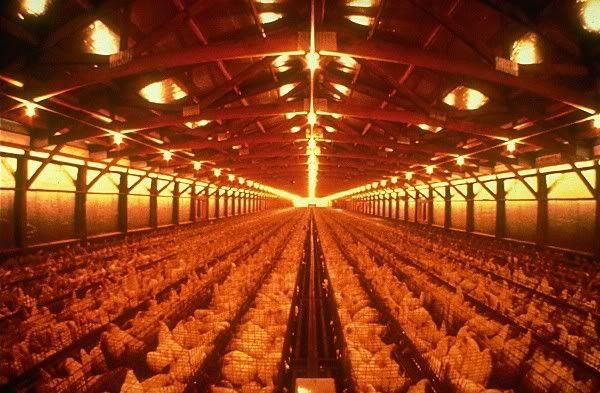Source: Turtle Planet
The US is the largest consumer of meat by far, and it is also the largest producer of meat. Most of the grazing animals used for meat are raised on rangeland west of the Mississippi. The use of rangeland takes up 788 million acres, [i] 40 percent of the land in the lower 48 states, and over 70 percent of the land area of the western states. Over most of this area, the grazing animals have totally displaced native grazing animals and the predators that formerly inhabited the region have been wiped out.

The USDA Animal Damage Control Division (ADC) kills over 80,000 predators a year, including bears, wolves, and mountain lions, for the benefit of private ranchers. In addition, the ADC wiped out 2.7 million nuisance animals such as squirrels and raccoons. State agencies exterminate even more. The losses from predation to the cattle industry are estimated to by one fifth of one percent of the cattle herd. By contrast, losses due to respiratory problems alone in cattle account for 5 times as many pre-slaughter deaths.
Although out on the range eating grass is the natural habitat for a ruminant such as cattle, there simply is not enough space for them all if we are to consume as much meat as we do in the US. The population of cattle is sustained by artificial means. In the industrialized world of modern meat production, cattle have been reduced to a commodity and a means of converting excess grain production into cheap protein.
When one of the 107 million head of cattle in the US reaches a weight of about 650 lbs, it is taken to a feedlot for finishing. At the feedlot, known in industry terms as a Concentrated Animal Feeding Operation (CAFO), the steer is forced to eat corn, soybean meal, even animal protein and waste products including poultry waste from broiler farms[ii], until he is literally bursting at the seams.
The number of cattle being raised has been increasing, but the number of farms and CAFOs have been decreasing. This is due to the growth of larger and larger CAFO factories. A moderate sized cattle feeding operation can handle over 30,000 head of cattle at one time. Feed and medicine is delivered by railcar and truckload around the clock. Much of the feed is mixed and processed right on site.

The consumption of corn by cattle, besides being unnatural, accounts for over half the corn grown in the US. A total of 80 million acres of corn is grown in the US, 7 million acres just for silage (chopped up and stored whole corn stalks) to feed dairy and beef cattle. Another 3 million acres of hay and alfalfa are grown for forage. This represents the product of 37 million acres of corn, or half the corn is harvested, is used for livestock feed.[iii]. Each head of cattle consumes about 1200 lbs of feed at the CAFO to produce 100 pounds of meat.
Corn is heavily subsidized, and is the cheapest source of calories for raising beef in a feedlot. Without subsidized corn, in fact, this process of raising cattle would probably not even exist. Since cattle did not evolve to eat grain, but grass, this diet causes bloating and sickness for the animals. It also causes the digestive system of the animal to become acidic.
The unnaturally acidic digestive system has caused other unforeseen problems for humans. This is because the steer are fed large quantities of antibiotics to maintain their health. The naturally occurring enteric bacteria in their gut has evolved recently to adapt to the acidic environment, giving rise to deadly strains of Escherichia Coli bacteria such as O157:H7 that can survive the trip through human stomachs and infect humans. This bacteria can live in the intestines of healthy cattle. The pathogen is usually introduced to the meat at slaughter because the cattle are covered with contaminated manure when brought to the slaughterhouse, or because the contents of the gut are spilled onto the meat.
Feeding a ruminant an unnatural diet of simple starches supplemented with protein, although causing immense gastric distress, causes the animal to gain weight very quickly. Much of this weight gain is in the form of intramuscular fat, or marbling. So besides being bad for the cow, it is bad for the consumer of the meat, due to the corresponding increase in saturated fat being taken in every bite. In order to maintain health of the animal, and to increase weight gain even more, the steer is fed or injected with antibiotics and steroids.
The steroid being fed the cow also end up in the fat and meat as well, and is a principal reason that hormone laced American beef is not allowed to be imported into European Union, and now even Switzerland is considering the same ban[iv].
The hormones used include oestradiol (estrogen), testosterone, progesterone, zeranol, trenbolone, and melegesterol acetate. Oestradiol is considered a cancer risk in humans. The use of sex hormones are indicated in causing early puberty in girls[v], and prostate cancer in men[vi]. The rate of breast cancer in the US is 50igher than that of women in Europe. The rate of prostate cancer in men is nearly 3 times higher in America than in France and 5 times higher than in Asia.[vii]
The mountainous quantity of manure that the feedlot cattle wade through for the last six months of their lives is teeming with deadly E. Coli and hazardous levels of hormones. This waste is then discharged into the environment, causing problems with aquatic systems, reducing fish populations by interfering with reproduction.
It is suspected that the practice of allowing cattle to be fed mechanically processed meat has led to the spread of mad-cow disease (BSE). This is because meat that is processed this way is forced under pressure from the spinal cord. This pressure can release pieces of spinal tissue into the meat. The brain and spinal tissue are suspected of carrying the prion that causes BSE.[viii]
For this reason, the USDA prohibited feeding beef back to cows in 1997. But it still allowable to feed blood products and beef fat and tallow to cattle. This practice still continues as a way of disposing of waste products from slaughterhouses. Since the late 90s, there is an increasing shift to using soy meal as a protein supplement for cattle, although the cost of soy has meal in comparison to waste products has slowed its use.
Soybeans are, however, a major crop used as livestock feed mostly for chickens and hogs. Most of the soybeans used are first processed to remove the oil; the pressed cake is then used as feed. Processed soy beans are feed to hogs and chickens in the form of concentrated animal feed, which is a combination of different ingredients to replace the natural diet of these animals. For the most part, production of hogs and chickens takes place in Confined Animal Feeding Operations in the US. This means that the animals spend their entire lives indoors.
Chickens are raised indoors by the thousands, often caged individually or five at a time in confinement with little room to move about. To prevent them from harming themselves or other chickens, the birds are often de-beaked, that is the upper 2/3 and lower 1/3 of their beaks are sheared off to prevent them from pecking their fellow cellmates. Often, to prevent the spread of diseases and to speed up growth, the feed is laced with antibiotics. The systematic use of antibiotics has been criticized because it could breed more resistant strains of bacteria and that the antibiotics could be present in the meat sold to consumers.
A total of 8.5 Billion chickens and turkeys are slaughtered in the US every year. This is roughly 4.6 Billion pounds live weight every month of slaughtered poultry. It takes a half-pound of feed for every egg produced. It takes 850 pounds of feed to produce 100 pounds live weight of chickens, and about 220 pounds of feed to produce 100 pounds of broilers, as a finished product. Each chicken consumed about 31 pounds of feed during its lifetime.
Hogs are increasingly being raised indoors the same as chickens. They are often confined indoors in pens their entire lives in these operations. A typical farm at one time had 100 hogs, now the typical farm has thousands of hogs. The number of hog farms has been reduced as the farm factories have grown. A typical sow in a factory farm never sees the light of day and rarely gets to leave a pen that does not even permit her to turn around.

Sow gestation crates, Courtesy Farm Sanctuary, © 2006.
This type of confinement practice has been outlawed in Europe and some states in the US. Even with confinement of sows, raising so many hogs in the same building requires that very small pens be used. Also, the pigs are not allowed to wallow in mud to cool themselves, and live on concrete floors. Water is periodically sprayed on the pigs to cool them in hot weather.
In fact, the breed of hogs being produced in the factory farms would not survive long outdoors, being lightly pigmented and nearly hairless.
The building that contains the hogs can be a hazardous place for humans. The level of dust and odor can be unbearable. Much of the odor is due to hazardous levels of ammonia from feces and urine, and hydrogen sulfide gas from manure pits. Hog confinement is particularly dangerous. Chronic obstructive pulmonary disease has been linked to working conditions in these facilities, as well as bronchitis, asthma, and toxic organic dust syndrome. The Iowa State University Extension Service recommends workers wear respirators, including full helmet type respirators with an oxygen supply for long-term protection in this environment.[ix] No study has determined the effect on the animals imprisoned in the building.
The manure generated from CAFO and Factory farms is a major source of pollution. Every day, the 10 million hogs in North Carolina produce more sewage than New York City and its boroughs. Often, this sewage is kept in open lagoons for treatment before discharge into waterways. The odor produced has made ghost towns out of the downwind areas. Not a single farm, no matter the size, treats the sewage to the same level of treatment that a similar size city would be expected to. Lagoon spillage and the runoff from fields sprayed with hog waste has caused fish kills and contaminated drinking water in North Carolina.
Hog producers, realizing that support for polluting rivers and destroying small towns is fading, are now seeking government subsidies to try and solve the sewage disposal problem. According to the swine industry, it wouldnt be profitable to actually clean up the pollution it causes all by itself.[x]

[i] Major Uses of Land in the United States, 1997. By Marlow Vesterby and Kenneth S. Krupa. Resource Economics Division, Economic Research Service, U.S. Department of Agriculture. Statistical Bulletin No. 973.
[iii] Agricultural Statistics 2004, USDA
[iv] Switzerland Considers Ban on US Meat http://www.meatnews.com/index.cfm?fuseaction=Article&artNum=12249
[v] Earlier Puberty in Girls linked to Beef Hormones http://www.organicconsumers.org/Toxic/hormoncancer.cfm
[vii] Prostate Cancer Epidemiology, National Cancer Institute, http://seer.cancer.gov/publications/prostate/
[ix] Livestock Confinement Dusts and Gases, Iowa State University Extension Service, 1992
Original source: http://jovianturtle.blogspot.com.es/

No hay comentarios:
Publicar un comentario